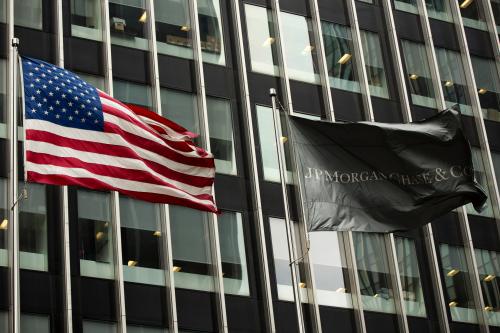President Obama has proposed various measures to restrict the size and scope of activity of the nation’s largest banks. These proposals are broadly in line with ideas being pushed by former Federal Reserve Chairman Paul Volcker and were announced in conjunction with a meeting between Volcker and the president. The key proposals all appear to require legislation and therefore are likely to undergo modification as a result of negotiations in Congress.
As this brief paper will hopefully make clear, the issues being addressed are complicated. This is a classic example of the devil being in the details and many of those details are simply unavailable. My own initial reaction is concern that the administration may be over-reacting to the risks it is trying to address, but it may be that further refinement of the proposals will address my concerns.
The biggest news comes from the president’s proposals to restrict proprietary trading and investments at the banks. Traditionally, banks took in deposits and put the money to work by lending it out and also by holding a substantial amount of fairly safe financial investments. These investments were held primarily because they provided more liquidity than loans, since they could be readily sold if needed, unlike loans. Sometimes investments were held because they would provide an unusually high return, but this was less common. Over the last couple of decades banks have substantially increased the level of investments that they held primarily for their higher expected returns and have ramped up the extent to which they traded in and out of securities opportunistically. Most of this activity is now done in units devoted to such “proprietary trading” where the bank’s own funds are invested in search of excess returns. Banks have also created or invested in external hedge funds for similar purposes, sometimes linked to an ability to earn fees from external investors for managing the hedge fund.
Many of the losses incurred by banks in the recent crisis occurred in their proprietary investment and trading books, although banks certainly lost money in more traditional ways as well. (For example, the mid-sized and smaller banks that are currently failing because of imprudent commercial real estate loans generally made their mistakes in very traditional ways. Larger banks are also losing a great deal of money on parts of their traditional lending activities, such as residential mortgage loans.) Chairman Volcker and a number of other observers have called for a limitation on the ability of banks to benefit from federally insured deposits, and the traditional liquidity supports provided by the Fed, if they are also going to do a significant volume of proprietary investment. The argument essentially is that cheap depositor funds should not be used to gamble in the financial markets.
The president proposes to essentially eliminate proprietary investments and ownership of hedge funds by banks. In addition to the risk management concerns, the administration has also cited the potential for conflicts of interest when a bank is both working with customers and making its own investments.
There is a clear appeal to keeping banks that benefit from deposit insurance and other public support, including potential taxpayer rescues, from taking undue investment risks. On the surface, it would appear fairly clearcut that they ought not to have major proprietary trading positions. However, the issue becomes far more complicated and less clear as one examines it.
First, it is harder than one might think to tell the difference between traditional investment activity, which is a necessary part of banking, and proprietary investments which are purely discretionary. Banks need to hold significant investment positions as part of their liquidity management and it has also generally been considered reasonable to invest the capital supplied by the bank’s shareholders into financial instruments. It is in everyone’s interest for the return on those investments to be maximized, within acceptable risk levels, since more profitable banks are stronger and in a better position to serve their customers. Part of that profit maximization comes from allowing banks to trade in and out of their investment positions as their situation changes or as they see market opportunities or threats. Therefore, it is somewhat difficult to draw a bright line between “proprietary investments” and traditional liquidity management activities. It is also hard to distinguish between investment and trading, since a significant amount of transactional activity can make sense even in a book that is essentially held for liquidity management purposes.
Second, banks have long been allowed to conduct certain trading activities to serve their clients. This is a relatively low risk business to the extent that it consists of trying to match buyers and sellers while earning a small spread for acting as the intermediary. It is often necessary for banks to buy positions from sellers before they have an end-buyer on the other side, in order to provide good service. This brings trading risk, since it is possible that they are not able to find that end-buyer at the price that they themselves paid. The need for these trading activities led banks to employ large numbers of in-house traders who developed substantial expertise. It was a natural next step to allow them to take certain positions on a somewhat longer-term basis when they could sense that the market was going to be moving in one direction or the other. It would not always be easy to distinguish these types of trades from ones that have a purer customer-based motive. Nor is it clear that we would want banks to give up the potential profits from the insights they gain through their general market activities.
Third, there is reason to believe that trading and investment activities should be unusually profitable for banks on average. The infrastructure they use for proprietary investments is generally already in place due to the need to hold large investment portfolios and to serve customers, therefore the marginal cost of adding proprietary investment activity can be low. In addition, a great deal of information flows through the largest banks. Some of this must be held confidential and cannot be shared even within the firm, but much of it can legitimately be shared. The insight gained from these information flows adds up to a significant market advantage that should yield excess returns on average. Again, all else equal, it is good public policy for the banks to engage in profitable activities that will make them stronger.
The key issue, therefore, is to determine when the risk created by proprietary investing exceeds the gain from allowing banks to engage in a generally quite profitable activity. Some observers clearly believe that proprietary investment almost always creates too much risk to the public. It appears that the administration is coming out on that side after a long period in which it had not placed major emphasis on this issue. My own view is that the situation is more nuanced and that regulators ought to have the ability to set limitations on proprietary investment and to set capital requirements for these activities that are high enough to hold the risk to the public to a very low level. Capital requirements can be quite effective as a risk management tool. At the extreme, a 100% capital requirement would mean that all the investment funds could be lost and it would not eat into any of the capital being used to back the rest of the bank’s activities.
The president also proposed that bank regulators be given the power to limit the size of any bank if its scale appears to create undue risk to the financial system. In particular, he proposed that the limits on deposit market share that already exist be extended to include all liabilities. This appears to be consistent with powers already incorporated into the financial regulatory reform bill that passed the House last year, although the president’s emphasis may increase the chance of those provisions surviving Congressional negotiations and even perhaps the probability of those powers being exercised by regulators in practice. If these provisions are included in the final legislation, it will be important to see whether the wording of the law tips the scales towards or away from their actual use. For example, limitations could be negotiated that would narrow the conditions under which regulators could take such an action. Alternatively, the law could provide a presumption that any bank over a certain size would be too big. There would also be a myriad of technical details surrounding how size would be measured. Banks might, for example, be able to able to slim down by moving significant amounts of assets into related entities or securitizing them out to unrelated parties while retaining some stake.
I am concerned, as a general matter, about arbitrarily limiting the size of the banks, since our modern, complicated, global economy demands that the U.S. have at least a few banks capable of providing a very wide range of services each on a large enough scale to be efficient. However, there certainly may be circumstances in which regulators ought to push a bank or banks to be smaller in general or smaller in certain activities. The question is how to balance the considerations and avoid arbitrary limits or decisions.









Commentary
Op-edRestricting Bank Activities
January 21, 2010